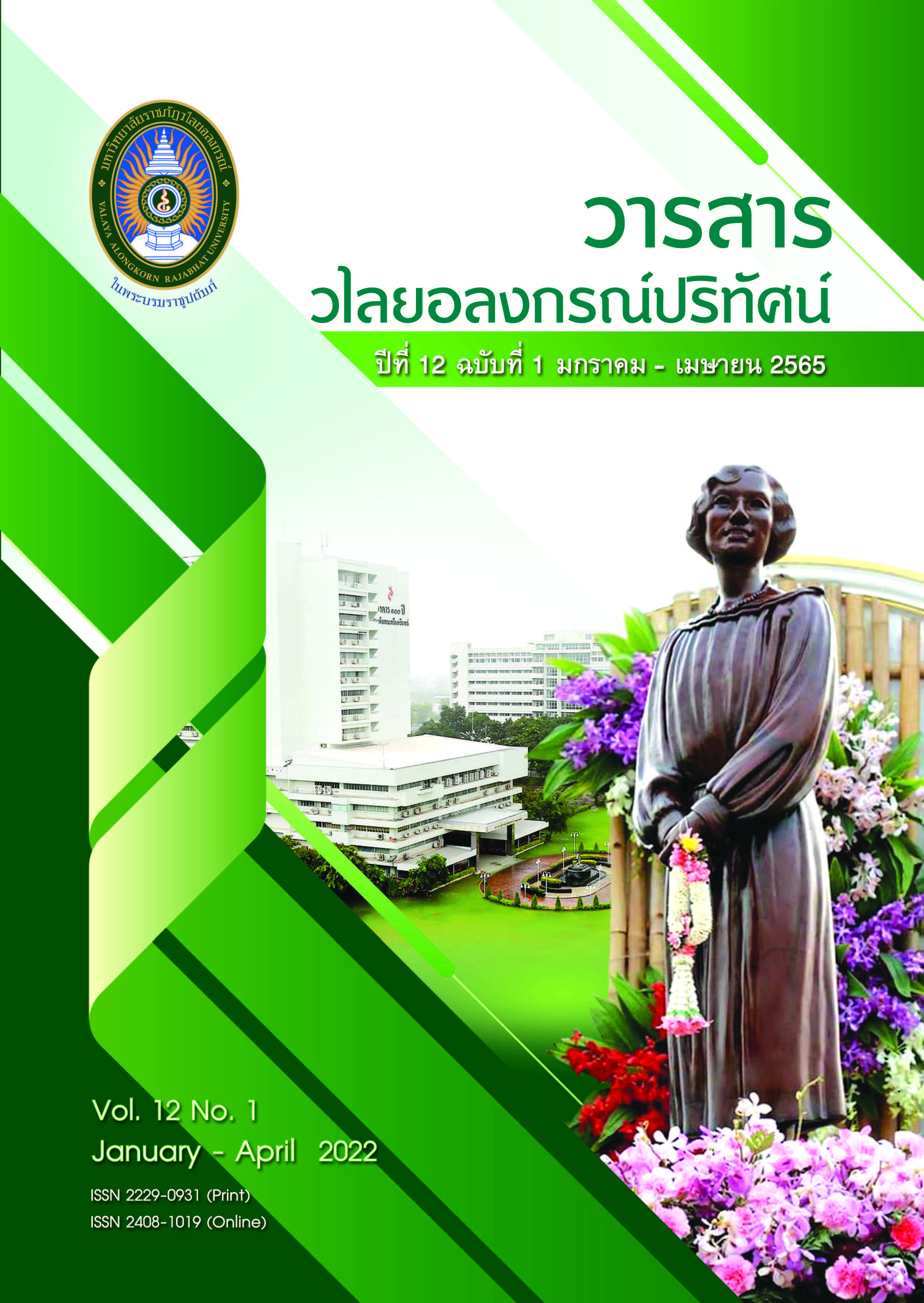การเรียนรู้คำศัพท์ภาษาอังกฤษจากการใช้สื่อสังคมในชีวิตประจำวันของนักศึกษามหาวิทยาลัยราชภัฏวไลยอลงกรณ์ ในพระบรมราชูปถัมภ์
คำสำคัญ:
สื่อสังคม, คำศัพท์ภาษาอังกฤษ, กระบวนการเรียนรู้คำศัพท์ภาษาอังกฤษบทคัดย่อ
งานวิจัยนี้มีวัตถุประสงค์เพื่อ 1) ศึกษาความสัมพันธ์ระหว่างความถี่ในการใช้สื่อสังคม ในชีวิตประจำวันกับปริมาณคำศัพท์ภาษาอังกฤษที่นักศึกษาได้เรียนรู้ และ 2) ศึกษาความสัมพันธ์ระหว่างการปฏิบัติตามกระบวนการเรียนรู้คำศัพท์ภาษาอังกฤษจากการใช้สื่อสังคมในชีวิตประจำวันกับปริมาณคำศัพท์ภาษาอังกฤษที่นักศึกษาได้เรียนรู้ การศึกษาในครั้งนี้เป็นการวิจัยเชิงปริมาณ กลุ่มตัวอย่างของการวิจัยเป็นนักศึกษามหาวิทยาลัยราชภัฏวไลยอลงกรณ์ ในพระบรมราชูปถัมภ์ ชั้นปีที่ 3 ในชั้นเรียนวิชา VLE310 ภาคเรียนที่ 1 ปีการศึกษา 2564 จำนวน 42 คน เครื่องมือที่ใช้ ในการเก็บรวบรวมข้อมูล คือ แบบสอบถาม ซึ่งผ่านการพิจารณาความตรงจากดัชนี ความสอดคล้องระหว่างข้อคำถามกับวัตถุประสงค์ไม่น้อยกว่า 0.6 และค่าความเที่ยงอยู่ระหว่าง 0.81-0.94 ข้อมูล ที่ได้นำมาวิเคราะห์ค่าเฉลี่ย ส่วนเบี่ยงเบนมาตรฐาน และค่าสัมประสิทธิ์สหสัมพันธ์แบบเพียร์สัน
ผลการวิจัยแสดงให้เห็นว่า ความถี่ในการใช้สื่อสังคมในชีวิตประจำวันมีความสัมพันธ์ ไปในทิศทางเดียวกันกับปริมาณคำศัพท์ภาษาอังกฤษที่นักศึกษาได้เรียนรู้ที่ระดับนัยสำคัญ .01 (ค่าสัมประสิทธิ์สหสัมพันธ์ 0.722) และแสดงให้เห็นว่าการปฏิบัติตามกระบวนการเรียนรู้คำศัพท์ภาษาอังกฤษจากการใช้สื่อสังคมมีความสัมพันธ์ไปในทิศทางเดียวกันกับปริมาณคำศัพท์ภาษาอังกฤษที่นักศึกษาได้เรียนรู้ที่ระดับนัยสำคัญ .01 (ค่าสัมประสิทธิ์สหสัมพันธ์ 0.787) เช่นกัน
เอกสารอ้างอิง
ชูศรี วงศ์รัตนะ. (2560). เทคนิคการใช้สถิติเพื่อการวิจัย. (พิมพ์ครั้งที่ 13). กรุงเทพฯ: ศูนย์หนังสือจุฬาลงกรณ์มหาวิทยาลัย.
มัลลิกา บุนนาค. (2539). สถิติเพื่อการตัดสินใจ. กรุงเทพฯ: ภาควิชาสถิติ คณะพาณิชยศาสตร์และการบัญชี จุฬาลงกรณ์มหาวิทยาลัย.
Abbas, A., Gulzar, R. & Hussain, Z. (2019). The impact of social media (Facebook and YouTube) on vocabulary acquisition of ESL learners. Journal of Communication and Cultural Trends. 1(1): 27-44.
AbuSa’aleek, A. (2015). Students’ perceptions of English language learning in the Facebook context. Teaching English with Technology. 15(4): 60-75.
Arif, T. (2019). The use of social media for English language learning: An exploratory study of EFL university students. Journal of English Language Literature and Teaching. 3(2): 224-233.
Arndt, H. & Woore, R. (2018). Vocabulary learning from watching YouTube videos and reading blog posts. Language Learning & Technology. 22(3): 124-142.
Cater, R. (2001). Vocabulary. In R. Cater & D. Nunan (Eds.), The Cambridge Guide to Teaching English to Speakers of Other Languages. Cambridge: Cambridge University Press.
Decarrico, J. (2001). Vocabulary learning and teaching. In M. Celce-Murcia (Ed.), Teaching English as a Second or Foreign Language. Heinle & Heinle Thomson Learning: Boston.
Farahani, D. & Fakhr, M. (2020). The relationship between Iranian language learners’ vocabulary knowledge and their out-of-class exposure to English reading, listening, and audiovisual materials. Journal of Foreign Language Research. 10(3): 484-497.
Fernandez, B. & Schmitt, N. (2015). How much collocation knowledge do L2 learners have?: The effects of frequency and amount of exposure. International Journal of Applied Linguistics. 166(1): 94-126.
Jahromi, D. (2020). A quantitative study of the perceived impact of social media networks on Bahraini users’ English language learning. Teaching English with Technology. 20(4): 23-40.
Kasuma, S. (2017). Using Facebook for English language learning: The differences among gender and ethnicity. Journal of Nusantara Zainal Abidin. 2(1): 177-193.
Kemp, S. (2021). Digital 2021: Thailand. [Online], Available: https://datareportal.com/reports/digital-2021-thailand. (2021, 28 April).
Krejcie, R. & Morgan, D. (1970). Determining sample size for research activities. Educational and psychological measurement. 30: 607-610.
Likert, R. (1932). A technique for the measurement of attitudes. In Archives of Psychology. (1–55). New York: The Science Press.
Ma, Q. (2017). Technologies for teaching and learning L2 vocabulary. In C. A. Chapelle & S. Sauro (Eds.), The handbook of technology and second language teaching and learning. Hoboken: Wiley-Blackwell.
Niitemaa, M. (2020). Informal acquisition of L2 English vocabulary: Exploring the relationship between online out-of-school exposure and words at different frequency levels. Nordic Journal of Digital Literacy. 15(2): 86-105.
Nirattisai, S. (2014). Vocabulary Size and Vocabulary Learning Strategies of Thai University Students. Master of Arts Thesis in Teaching English as an International Languages, Prince of Songkla University.
Peters, E. (2018). The effect of out-of-class exposure to English language media on learners’ vocabulary knowledge. International Journal of Applied Linguistics. 169(1): 142-168.
Sim, M. & Pop, A. (2014). The impact of social media on vocabulary learning case study-Facebook. Annals of the University of Oradea, Economic Science Series. 23(2): 120-130.
ดาวน์โหลด
เผยแพร่แล้ว
รูปแบบการอ้างอิง
ฉบับ
ประเภทบทความ
สัญญาอนุญาต
ลิขสิทธิ์ (c) 2022 วรวรรณ วงศ์ศรีวิวัฒน์

อนุญาตภายใต้เงื่อนไข Creative Commons Attribution-NonCommercial-NoDerivatives 4.0 International License.
ข้อความที่ปรากฏในบทความแต่ละเรื่องในวารสารวไลยอลงกรณ์ปริทัศน์ เป็นความคิดเห็นของผู้นิพนธ์แต่ละท่าน มิใช่เป็นทัศนะและมิใช่ความรับผิดชอบของกองบรรณาธิการจัดทำวารสาร และ
มหาวิทยาลัยราชภัฏวไลยอลงกรณ์ ในพระบรมราชูปถัมภ์


